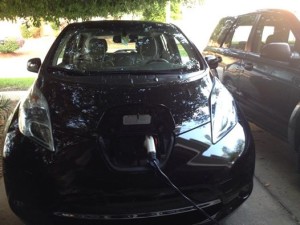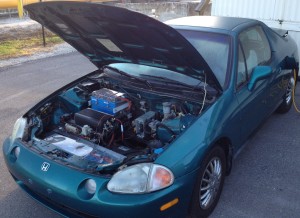This article is by Tom Blair, a fellow engineer with Tampa Electric’s Engineering & Project Management team.
As the enthusiastic owner of an electric vehicle (EV), I’m eager to see more of these environmentally responsible cars and trucks on the road – and that’s exactly what seems to be happening with the support of companies like Tampa Electric.

But with different types of EVs available, what are the pros and cons of owning an electric vehicle from the original equipment manufacturer (OEM) and one that was converted from using gasoline, like mine?
Recently, I had the chance to find out when I was contacted by Kenneth Hernandez, program manager with Energy Management Services at Tampa Electric. Knowing about my Honda Del Sol (converted from gasoline to 100 percent electric), he asked if I would like to test drive the Nissan Leaf all-electric car for a week to get my feedback about how the vehicles compare. What I found were some interesting differences between the two that might make it easier for you to decide which kind is right for you.
Battery and range: The most expensive component in any electric vehicle is the battery. An EV averages about one mile for every two amp-hours of energy used, and it’s the battery rating in amp-hours that determines the range of the vehicle. The Leaf and my conversion car both use batteries rated at 160 amp-hours, which puts the range of these cars at about 80 miles. On my car, the battery was comprised of 40 cells with a total cost of $9,000. To increase the range of an EV requires a larger amp-hour-rated battery, with increased cost for the battery and the EV. To achieve the 260-mile range similar to a Tesla would require a battery with 520 amp-hour capacity. If I were to design and build a conversion car with a 260 mile range using the same type of battery cells that I have in my existing car, it would require 130 cells at an estimated cost of $30,000. This is a major reason OEM vehicles with longer ranges are more expensive.

You can charge the battery with three possible chargers. Level 1 (120-volt) are the most common, but they take the longest time to charge, providing about four miles range for every hour of charge. Level 2 (240-volt) chargers are faster, providing 12 miles for every hour of charge. A relatively new development is the DC “fast charger” which is supplied with three-phase, 480-volt power can that provide 110 miles of range for one hour of charging.
The engine: When you step on the gas pedal of a car, you are not looking for a certain speed, but a certain amount of torque from the car. Most EV conversion cars use a DC motor, which has lower initial cost, but higher maintenance – while OEMs use an AC motor, which has higher initial cost, but less maintenance. The AC motor is more efficient as it can regenerate back into the batteries while braking. This makes the OEM car more energy-efficient.
Miles per gallon: Another thing that is different between gasoline-engine cars and EVs is their efficiency when comparing highway driving to city driving. The typical gasoline car is more efficient when driving on the highway versus city driving. The electric car is more efficient during city driving compared to highway driving. The primary reason is that when stopped at red lights, gasoline cars are expending energy in the form of heat from the engine, while an electric car expends substantially less energy due to auxiliary electrical loads in the car when stopped.
Technology: Another difference between conversion electric vehicles and OEM-designed EVs is the onboard technology. My conversion car does not have power steering or air conditioning (both were lost when the engine was removed). New EV cars have these features and also have conveniences like heated seats, GPS and Bluetooth interface with the radio. It has a computer screen with details of the car’s energy efficiency to help the driver improve the range of the EV. If comfort is your goal, then OEM-designed EVs are move suited to your needs. One of the benefits of converting a car to electric is you can choose the chassis design that you want. The Del Sol conversion car is a convertible and EV convertibles are not yet widely available.
I’ve been sold on EV technology ever since I started driving my EV conversion vehicle last year. I find it much more convenient to plug in at home and work instead of having to stop by a gas station every few days to fill up. The car is very quiet as well. It’s more efficient in city driving conditions, which is most of my driving. It’s also a great way to meet new people when they see the EV and they ask questions about the car’s technology.
After a week with the Leaf, I’m acutely aware of the differences between it and my converted EV. I hope this helps you decide what kind of EV might work best for you. For me, the bottom line is that either way, I’m better off in an electric vehicle.


No Comments Found